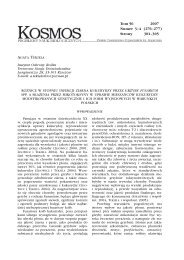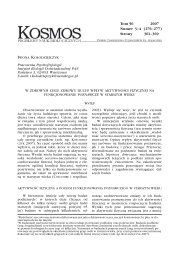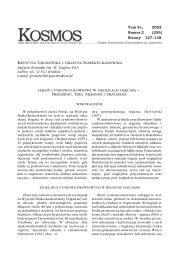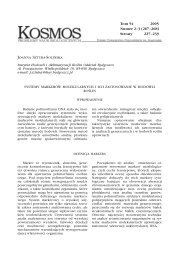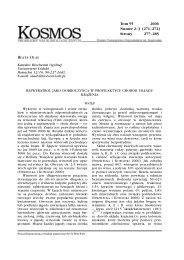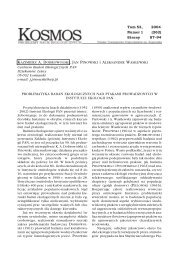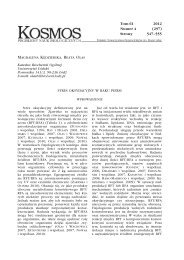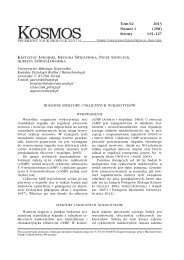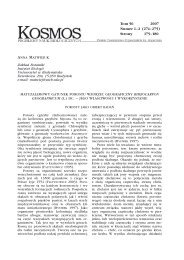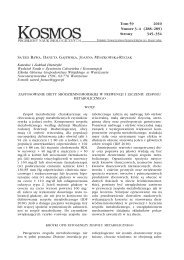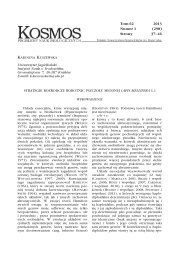WŁODZIMIERZ PTAK, MARIA PTAK i BARBARA PŁYTYCZ 2
WŁODZIMIERZ PTAK, MARIA PTAK i BARBARA PŁYTYCZ 2
WŁODZIMIERZ PTAK, MARIA PTAK i BARBARA PŁYTYCZ 2
Create successful ePaper yourself
Turn your PDF publications into a flip-book with our unique Google optimized e-Paper software.
dziesiêciu laty, wymaga obecnie uzupe³nieñ<br />
(MATZINGER 2002, VANCE 2000).<br />
Wiod¹ce czasopisma immunologiczne prezentuj¹<br />
próby integracji lawinowo narastaj¹cej<br />
wiedzy na temat aktywacji uk³adu odpornoœciowego,<br />
uwypuklaj¹ce interakcjê bia³ek szoku<br />
cieplnego (HSP) z receptorami TLR (WALLIN i<br />
wspó³aut. 2002, KUMARAGURU i wspó³aut. 2003,<br />
JOHNSON i wspó³aut. 2003) (Ryc. 3D).<br />
W œwietle tych danych hipotezy Janewaya i<br />
MATZINGER nie stoj¹ w sprzecznoœci, lecz uzupe³niaj¹<br />
siê nawzajem, staj¹c siê kamieniami<br />
milowymi na drodze do powstania nowego paradygmatu.<br />
WHAT THE IMMUNE SYSTEM IS RECOGNIZING. TOWARDS THE NEW PARADIGM<br />
Individuals are protected against infections by<br />
two mechanisms. The first one non-specific, innate immunity<br />
which provides an early protection and is executed<br />
mainly by phagocytic cells, and the later one developing<br />
specific adoptive immunity which depends<br />
on B and T lymphocytes equipped in clonally distributed<br />
antigen-specific receptors. T cells recognize an<br />
antigen only when presented by the antigen presenting<br />
cells (APC), i.e. B lymphocytes, macrophages or<br />
dendritic cells (APC) (Signal I). APCs in turn produce<br />
an array of different mediators that stimulate T cells to<br />
perform their antigen-specific functions (Signal II). As<br />
shown by C. A. Janeway, APCs produce Signal II only<br />
upon recognition of highly conserved structures (patterns)<br />
on the surface of pathogens (PAMPs) by<br />
cell-membrane bound non-clonal wide-specific receptors<br />
(PRR) (e.g. toll-like receptors, TLR). Only then<br />
they decide whether the specific immune response<br />
ABBAS A. K., LICHTMAN A. H., POBER J.S., 2000. Cellular<br />
and molecular immunology. 4th Edition. W.B.<br />
Saunders Company, Philadelphia. PA,.<br />
ADEREM A., ULEVITCH R. J., 2000. Toll-like receptors in<br />
the induction of the innate immune response.Nature<br />
406, 782–787.<br />
AGRAWAL A., EASTMAN Q.M., SCHATZ D. G., 1998. Transposition<br />
mediated by RAG1 and RAG2 and its implications<br />
for the evolution of the immune system.<br />
Nature 394, 744–751.<br />
BENDELAC A., MEDZITOV R., 2002. Adjuvants of immunity:<br />
harnessing innate immunity to promote adoptive<br />
immunity. J. Exp. Med. 195, F19–23.<br />
BEUTLER B., 2000. The Toll-like receptors as the primary<br />
sensor of the innate immune system. Immunologist,<br />
8, 123.<br />
BRIGHTBILL H. D., MODLIN R. L., 2000. Toll-like receptors:<br />
molecular mechanisms of the mammalian immune<br />
response. Immunology 101, 1–10.<br />
FEARON D. T., LOCKSLEY R. M., 1996. The instructive role<br />
of innate immunity in the acquired immune response.<br />
Science 272, 50–53.<br />
HACKER G., REDECKE V., HACKER H., 2002. Activation of<br />
the immune system by bacterial CpG–DNA. Immunology<br />
105, 245–251.<br />
HOFFMANN J. A., KAFATOS F. C., JANEWAY C. A., EZEKOWITZ<br />
R. A., 1999. Phylogenetic perspectives in innate<br />
immunity. Science 284, 1313–1318.<br />
Co rozpoznaje uk³ad immunologiczny? 155<br />
Summary<br />
LITERATURA<br />
will be induced at all, and also determine the type of<br />
effector mechanisms (humoral or cellular). In the<br />
“danger hypothesis” by P. Matzinger, more important<br />
than recognition of a foreign antigen is recognition of<br />
danger signals produced by cells exposed to different<br />
kinds of stress (e.g. heat shock proteins, HSP). These<br />
signals then activate APCs that, in turn, present antigen<br />
to lymphocytes. Antigens that do not cause cell<br />
damage (including also some bacterial antigens) are<br />
non-immunogenic. Moreover, the effector mechanisms<br />
triggered by an antigen are determined not by<br />
the antigen itself but by signals flowing from tissues in<br />
which antigen is recognized. These models are not<br />
mutually exclusive. The integrative hypothesis<br />
stresses the role of both microbial products and endogenous<br />
macromolecules in activation of the immune<br />
surveillance.<br />
JANEWAY C. A,1989. Aproaching the asymptote?. Evolution<br />
and revolution in immunology. Cold Spring<br />
Harbor Symp. Quant. Biol. 54, 1–13.<br />
JANEWAY C. A., 1998. The road less traveled by the role<br />
of innate immunity in the adaptive immune response.<br />
J. Immunol. 161, 539–544.<br />
JANEWAY C. A.,1992. The immune system evolved to discriminate<br />
infectious nonself from non-infectious<br />
self. Immunol. Today 13, 11–16.<br />
JOHNSON G. B., BRUNN G. J., TANG A. H., PLATT J. L., 2003.<br />
Evolutionary clues to the functions of the Toll-like<br />
family as surveillance receptors. Trends Immunol.<br />
24, 19–24.<br />
KARIN M., DELHASE M., 2000. The I Kappa B Kinase<br />
(IKK) and NF kappa B: Key elements of proinflammatory<br />
signaling. Semin. Immunol. 12,<br />
85–98.<br />
KUMARAGURU U., PACK C., ROUSE B. T., 2003. Toll-like receptor<br />
ligand links innate and adaptive immune<br />
responses by the production of heat-shock proteins.<br />
J. Leukocyte Biol. 73, 574–583.<br />
MATZINGER P., 1994. Tolerance, danger, and the extended<br />
family. Annu. Rev. Immunol. 12, 991–1045.<br />
MATZINGER P., 2001. The danger model in its historical<br />
context. Scand. J. Immunol. 54, 4–9.<br />
MATZINGER P., 2002. The danger model: a renewed sense<br />
of self. Science 296, 301–305.



